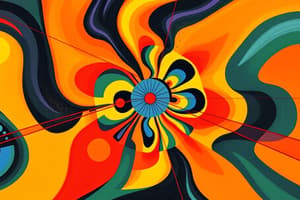Podcast
Questions and Answers
What determines the resonant frequency of an object?
What determines the resonant frequency of an object?
- The color of the object
- The temperature of the object
- The size and shape of the object, along with the material it is made from (correct)
- The weight of the object
What is the amplitude of a vibrating object?
What is the amplitude of a vibrating object?
- The point of greatest speed
- The point of constant motion
- The point of greatest distance a vibrating object moves from its equilibrium (correct)
- The point of least distance a vibrating object moves from its equilibrium
Why does resonance not occur if the vibrating frequency does not match the resonant frequency of the item?
Why does resonance not occur if the vibrating frequency does not match the resonant frequency of the item?
- Because the item is too light
- Because the item is too heavy
- Because the item is not made of a suitable material
- Because the frequency of the initial object's external vibration does not match the resonant frequency of the second object (correct)
What is an example of resonance in everyday life?
What is an example of resonance in everyday life?
What is the Latin root of the word 'resonance'?
What is the Latin root of the word 'resonance'?
What is a common characteristic of standing waves?
What is a common characteristic of standing waves?
What is the purpose of resonance in musical instruments?
What is the purpose of resonance in musical instruments?
What happens when a light wave hits an object that is not at its resonant frequency?
What happens when a light wave hits an object that is not at its resonant frequency?
What is the function of a capacitor in an RLC circuit?
What is the function of a capacitor in an RLC circuit?
What is the term for the points on a standing wave that do not move?
What is the term for the points on a standing wave that do not move?
What happens when the light wave frequency matches the resonant frequency of the object?
What happens when the light wave frequency matches the resonant frequency of the object?
Why is the blue color of a blue ball visible to humans?
Why is the blue color of a blue ball visible to humans?
What happens to the light wave in transparent objects?
What happens to the light wave in transparent objects?
When a light wave causes a short vibration in an object, what happens next?
When a light wave causes a short vibration in an object, what happens next?
Why do objects appear in different colors?
Why do objects appear in different colors?
Flashcards are hidden until you start studying
Study Notes
What is Resonance?
- Resonance occurs when a vibrating object causes another nearby object to start vibrating at a higher amplitude.
- Resonance is possible because objects and systems naturally vibrate at a definitive frequency, called the resonant frequency or natural frequency.
- The resonant frequency is determined by the size and shape of the object, along with the material it is made from.
- Resonance occurs when the frequency of an initial object's external vibration matches the resonant frequency of a second object, resulting in a higher amplitude vibration.
When Does Resonance Occur?
- Resonance occurs when an item oscillates or vibrates in response to exposure of oscillations at a frequency that matches or is close to matching its resonant frequency.
- Resonance will not occur if the vibrating frequency does not match the resonant frequency of the item.
Wave Resonance
- A wave is a disturbance that moves through a material from a given point to another point.
- A standing wave is a wave that is associated with resonance, resulting from two separate waves with matching frequencies and moving in opposing trajectories interfering with each other.
- Standing waves do not appear to travel and appear to oscillate in place.
- Standing waves feature two points along the wave that do not move, called nodes, and points where the standing wave has the largest amplitude, called antinodes.
Examples of Resonance
- Resonance can be observed in RLC circuits, musical instruments, and light waves.
- In RLC circuits, resonance happens when the induction and capacitance are the same in magnitude, but negate one another, resulting in the highest amount of power being transferred.
- In musical instruments, resonance amplifies sound waves to create louder sounds, resulting from an item vibrating after being exposed to sound waves at the resonant frequency.
- In light waves, resonance occurs when the frequency of the light wave matches the resonant frequency of the object, resulting in absorption of the light wave.
Studying That Suits You
Use AI to generate personalized quizzes and flashcards to suit your learning preferences.




